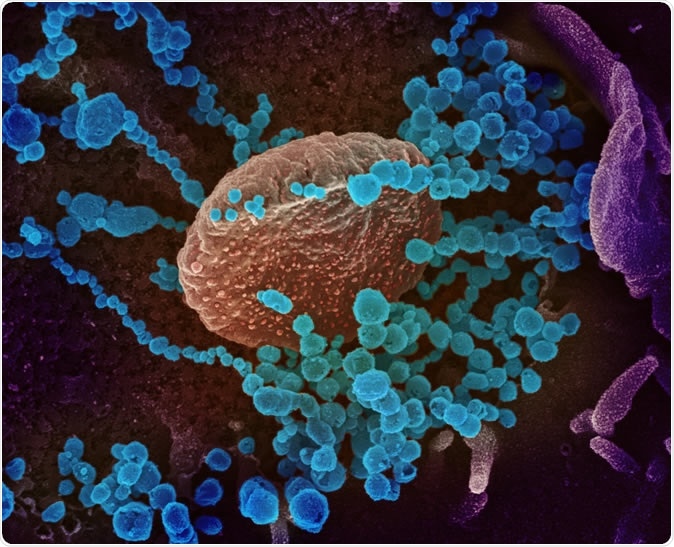The coronavirus disease (COVID-19) has ravaged across the globe, infecting a staggering 3.5 million people, and taking over 251,000 lives. One of the most significant concerns in this global pandemic is the possibility of reinfection as previous reports in South Korea and Japan show people testing positive with the coronavirus again.
Now, a team of South Korean researchers has revealed that reports of recovered coronavirus patients testing positive for severe acute respiratory syndrome coronavirus 2 (SARS-CoV-2) infection a second time round are due to testing errors and not actually reinfection.

Novel Coronavirus SARS-CoV-2 This scanning electron microscope image shows SARS-CoV-2 (round blue objects) emerging from the surface of cells cultured in the lab. SARS-CoV-2, also known as 2019-nCoV, is the virus that causes COVID-19. The virus shown was isolated from a patient in the U.S. Image captured and colorized at NIAID's Rocky Mountain Laboratories (RML) in Hamilton, Montana. Credit: NIAID
Dead virus fragments
The country’s infectious disease experts said that dead-virus fragments were most likely cause positive results for SARS-CoV-2 infection among 260 people who have recovered from the disease. The tests even showed the presence of these fragments even weeks after making full recoveries.
Oh Myoung-don, who spearheads the central clinical committee for emerging disease control in South Korea, said there was little reason to believe the cases had emerged from reactivation of the virus or reinfection.
“The tests detected the ribonucleic acid of the dead virus,” Dr. Oh, who is also a hospital doctor at the Seoul National University, explained.
The conventional test used to detect SARS-CoV-2 is the polymerase chain reaction test or PCR test. However, there are technical limitations to the test. It cannot distinguish whether the virus in the patient is alive or dead.
“PCR testing that amplifies genetics of the virus is used in Korea to test COVID-19, and relapse cases are due to technical limits of the PCR testing. The respiratory epithelial cell has a half-life of up to three months, and RNA virus in the cell can be detected with PCR testing one to two months after the elimination of the cell,” Dr. Oh explained.
So far, there were more than 260 people who tested positive again in South Korea. These patients have recovered and were declared virus-free.
The new report confirmed a previous assessment of the Korean Centers for Disease Control and Prevention that patients who tested positive again had little or no contagiousness at all. This means that they cannot transmit the virus to others, based on virus culture cells that all failed to find live viruses in recovered patients.
The resurgence of the virus
The reports of reinfection in the country have sparked panic, as South Korea has already flattened the curve after extensive mass testing and isolation of cases. It is one of the countries that have controlled the spread of the virus without resorting to restrictions and lockdowns.
Though many measures have contributed to South Korea’s success in containing the virus spread, two measures were critical in its ability to flatten the curve – extensive testing and a national system for effectively tracking infected persons. Being able to trace those who are positive with the virus, and their contacts can help isolate cases immediately before they even transmit the virus to others.
Virus resurgence is a problem not only in South Korea but also in other countries who had successfully flattened the curve. In some countries, such as Japan, they see a sudden spike of new cases due to the premature lifting of restrictions. Governments need to impose a “new normal” across industries to prevent a second wave of the outbreak.
In South Korea, health officials reported only ten new infections every day for the past 11 days. During the initial stages of the pandemic, the country has been leading with high infection rates, until its health measured helped “flatten the curve.” Its total case toll reached 10,801, with 252 deaths.
In comparison, many countries reported spikes of confirmed cases. The United States has reported a whopping 1.18 million confirmed cases and more than 68,000 deaths. Spain and Italy follow with more than 218,000 and 211,000 confirmed cases, respectively.
The United Kingdom has reported more than 191,000 cases and 28,809 deaths. The UK has the second-highest death toll, next to Italy, with 29,079 deaths. The death rate of Italy is 13.7 percent, the UK is 15.1 percent, while Spain has a fatality rate of 11.6 percent.